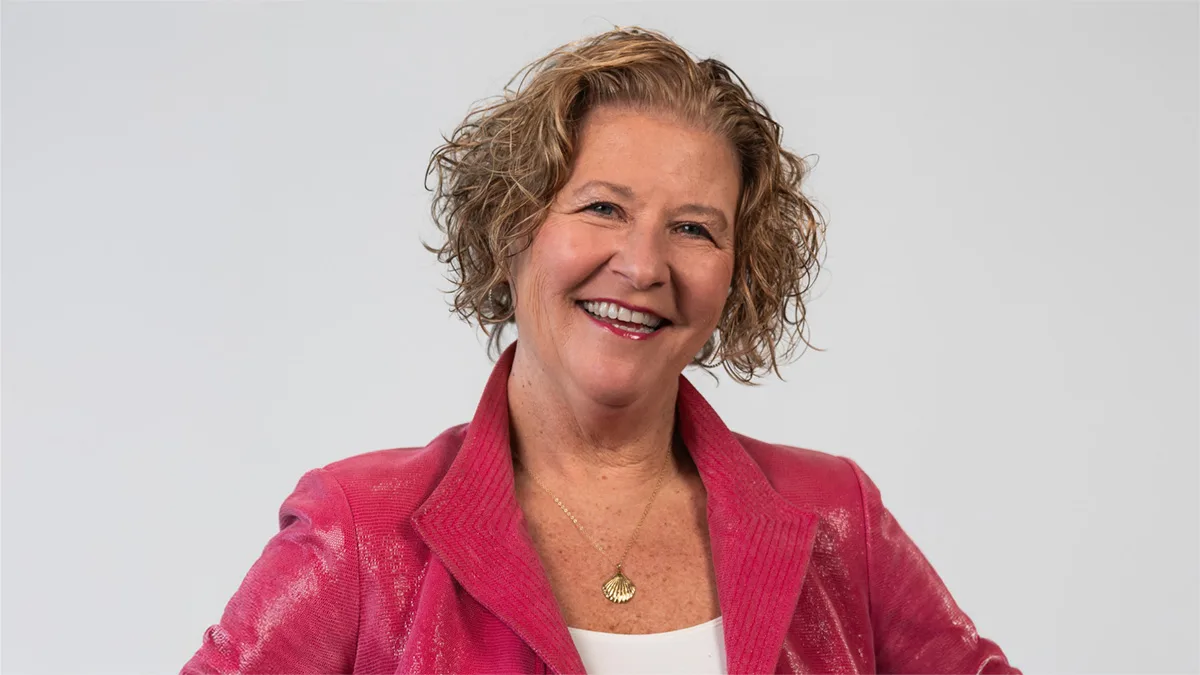
Overview
With a proven track record of driving innovation, scaling companies, and navigating complex regulatory landscapes, Anderson continues to lead the charge in making personalized diagnostics a reality for people worldwide.
Pioneer of developing tests that are accessible, clinically useful and financially viable
Bonnie Anderson has spent decades revolutionizing the diagnostic industry, from spearheading the global expansion of Veracyte to co-founding PinkDx, a trailblazing company focused on women's health.
Known for her strategic vision and expertise in genomics, Anderson's work has made personalized medicine more accessible, clinically useful and financially viable, redefining how diagnostic tests can transform patient care.
Hers is an impressive track record for anyone committed to one of the toughest businesses in the life sciences — especially for a female leader of her generation.
The company she helped to start and led for 14 years, Veracyte, has transformed itself and grown steadily, continually adopting new technologies and expanding globally. It expects to post revenues of more than $440 million this year.
Anderson stepped away three years ago from her role there as Chair of the Board and founding CEO. Still, Veracyte’s current success is mainly due to her sophisticated understanding of the nuances of the science and the diagnostics business and her organizational skills.
Now, she is starting another diagnostics company with a similar strategic playbook in a different field of medicine. PinkDx focuses on solving unmet medical needs for women, raising a $40 million Series A — one of the largest financing for an early-stage diagnostics company in 2024. The money came in even before the company identified a particular indication or settled on a technology to develop.
Innovating the Business Model for Genomic Testing
Anderson’s career trajectory in the rough and tumble world of diagnostics has coincided with the explosion of new diagnostic tests related to the Human Genome Project, completed in 2003.
In 2008, a group of pedigree venture capitalists wanted to replicate their success in a different area of genomic testing. They had already scored big with the success of a pioneering genomics testing company called Genomic Health. They had formed an incubator but had yet to find a top executive to help define an unmet need that their company could address with a strong business case — and who could ultimately lead it. Anderson had just retired from a senior position at Beckman Coulter, a leading diagnostics manufacturer (now part of Danaher), and was looking for opportunities in the startup world.
Genomic Health was one of the first business success stories in genetic testing. In addition to developing a test that could change clinical practice, its leaders bet that spending a lot of money on high-quality clinical evidence--unusual for old-school diagnostics companies—and the importance of that data in obtaining reimbursement premiums—could create a commercially viable roadmap for molecular testing that previously did not exist.
Their efforts ultimately provided a template that serves as the foundation for precision medicine initiatives changing how our society approaches disease.
At the time, reimbursement for genetic testing was minimal at best and well below the development costs. Genomic Health changed that paradigm.
Inspired by the company, an early class of companies raised “significant capital necessary for developing high levels of evidence, which we knew would be needed for making clinical and payor decisions based on our tests,” Anderson said.
Early innovators in genomic medicine almost always started with a technology or interesting new biomarker and then focused on where to apply it. In contrast, Veracyte’s backers were determined to start with a clinical problem and business case.
“It takes a lot of different avenues to figure out how to build and scale in diagnostics,” Anderson said. “The recipe is to really understand the patient journey and the questions you want to answer. What is the real unmet need?”
The founders wanted to identify explicitly a big, underserved market opportunity that did not have a lot of competition for providers’ attention and let Veracyte scientists figure out the technological solution.
Once the company had an answer, it could, like Genomic Health, build peer-reviewed evidence of clinical utility and submit those results for regulatory approval and reimbursement.
The subtle problem they settled on could be defined as follows: too many people were getting unnecessary surgery due to inadequate cytology diagnostics.
If Veracyte could erase ambiguity from this process by helping doctors distinguish between benign and cancerous cases using non-invasive testing, through what it called classifiers, it could improve care and take unnecessary costs out of the system, demonstrating value to patients, providers and payers.
Veracyte’s first product, the Afirma Genomic Sequencing Classifier, was an endocrinology test for differentiating benign from malignant thyroid nodules. At the time, about 30 percent of the more than 500,000 fine needle aspirates (FNA) biopsies performed annually on thyroid nodules produced indeterminate results. Most of these patients then received diagnostic surgery that removed all or part of their thyroids, yet 70 to 80 percent of such patients ultimately proved to have benign nodules, meaning the surgery was unnecessary.
Afirma eliminates the need for follow-up surgery in 70 percent of cases by ruling out malignancies with close to 100 percent accuracy. The test is performed with other standard cytology tests on FNAs.
During Bonnie’s tenure as CEO, Veracyte estimated that its tests saved well over 175,000 patients from having their thyroids removed and being placed on lifelong hormone replacement therapy, resulting in reducing costs to payers by tens of millions of dollars, given the average cost of follow-up surgery is estimated to be $21,000.
The Importance of Building a Comprehensive Cohort for Clinical Specificity in Testing
Over time, as Veracyte strove to expand technologically and commercially. It incorporated many state-of-the-art technologies into its diagnostics platform, integrating them as needed, depending on the application.
The resulting tests address different gaps in the patient journey for multiple diseases. These include ruling in or out which patients should get surgery or other treatments, and prognostic indicators that help physicians make decisions about treatments for prostate, bladder, and breast cancers and interstitial lung diseases, the latter of which are a combination of conditions, many of which are benign but some of which are fatal.
Anderson said the point has been to find better tests that answer questions earlier or less invasively. Its Envisia Genomic Classifier, for example, uses transbronchial biopsy samples to identify patients with a particular type of interstitial lung disease called IPF, which previously required surgery.
Fundamental to Veracyte’s success has been its work on building internal clinical cohorts that previously existed on a limited basis or were nonexistent, which allowed it to test different kinds of samples at various points of the patient journey, said Anderson.
Its large thyroid nodule cohort, for example, is generally unusual in medicine as it includes both benign and malignant samples, a characteristic crucial to developing tests with high accuracy.
Surgical tissue banks for cancer tend to have positive samples only, but collections of negative and ambiguous samples are also important for developing high-performance rule-out tests that are impactful, Anderson pointed out. The samples should represent all underlying nuances of the genomic data represented in benign conditions and cancerous situations, she said.
Also key to properly understanding test results is determining what cut-offs to use and the metrics the tests should measure. For Afirma, for example, a performance with high specificity is crucial – sensitivity mattered less because most patients were already going to surgery, but that is not always the case.
Taking Lessons to PinkDx
Anderson is following a similar playbook at PinkDx, which she co-founded in 2023. The COVID-19 pandemic was a difficult period for her both on a personal level and with the general pressures of guiding Veracyte’s global expansion under extreme circumstances. Anderson was ready to step away and let someone with expertise in scaling operational infrastructures take over.
She turned to her love of entrepreneurship and began building a company focusing on diagnostics for post-menopausal women’s health. If she could raise at least $25 million — the minimum requirement to run a diagnostics startup through to a value inflection point, she would go all in.
PinkDx seeks to identify specific, real problems for women and develop tests that make a difference in their care. Like Veracyte, it operates on a three-year roadmap that spells out a timeline of inflection points that deliver value—all geared to time fundraising goals.
The initial funds are building a broad cohort of different gynecological conditions, from which the company collects the data necessary to create signatures that lead to the development of diagnostic tests. Also, like Veracyte, PinkDx scientists use whole transcriptome analysis combined with machine learning to interrogate that data.
The cohort includes prospectively collected samples with longitudinal follow-up, giving it the richest database of its kind in women’s health. These discovery tools are not proprietary, but the way in which Veracyte uses them is distinct, Anderson said.
The company is enrolling women across multiple sites in two clinical trials. The outcome of these trials will clarify PinkDx’ focus going forward, Anderson added, although she would not speak about the details of those trials.
Clinical adoption of resulting tests will have to be based on delivering real value when addressing a question to which both clinicians and women want answers.
“It sounds like motherhood and apple pie, but that’s the truth,” Anderson said.
“When I started Veracyte, I never thought in a million years that I’d be running the company for 15 years. Founders often transition away from companies as they grow, but we were so excited about the ideas that we had that I wanted to stay and transform Veracyte into a differentiated, global company,” she continued. “Once you make the decision to change from being US-centric, with three or four products, to setting up global operations and different business models, all of a sudden, the company is really transformed into something new.”







